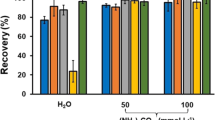Abstract
Activated charcoal is an adsorbent material which is consumed as a dietary supplement (100 mg) and as non-specific antidote treatment in acute poisoning at 0.5–1 g kg−1 body weight in infants and 50 g in adults. The ingestion of large quantities of it has aroused our interest in the presence of metals impurities. Therefore, the present study aimed to assess trace elements in activated charcoal products. Multielement analysis were performed using Inductively Coupled Plasma—Mass Spectrometry after digestion. Estimated daily Intake was calculated and compared to references doses for each element. Varying trace elements have been found: chromium (0.3383 ± 0.089 µg g−1), cadmium (0.5991 ± 0.2967 µg g−1), aluminum (0.7033 ± 0.1215 µg g−1), nickel (0.0111 ± 0.003 µg g−1), lead (0.0052 ± 0.0021 µg g−1), zinc (0.0414 ± 0.0076 µg g−1), and manganese (0.0036 ± 0.0006 µg g−1). when 50 g of activated charcoal is consumed by a 70 kg adult, aluminum estimated daily intake is 0.0005 mg/kg bw/day which exceeds the reference dose (0.0004 mg/kg bw/day). In the infants, consumption of 15 g of contaminated activated charcoal exposes to chromium, cadmium and aluminum as their estimated daily intake (0.00034; 0.0006; 0.0007 mg/kg bw/day respectively) exceed their reference doses (0.0003; 0.0005; 0.0004 mg/kg bw/day respectively). These trace elements are not without risk to consumers health. Activated charcoal products could be contaminated with elemental impurities. Pharmaceutical industries should be vigilant to raw materials (plants and wood) used in the preparation, these materials should come from unpolluted areas to avoid contaminations.
Graphical abstract



Similar content being viewed by others
Data availability
The data collected and analyzed for this study can be shared upon request.
References
Abernethy DR, DeStefano AJ, Cecil TL, Zaidi K, Williams RL (2010) Metal impurities in food and drugs. Pharm Res 27(5):750–755. https://doi.org/10.1007/s11095-010-0080-3
Andujar P, Bensefa-Colas L, Descatha A (2010) Intoxication aiguë et chronique au cadmium. Rev Med Interne 31(2):107–115. https://doi.org/10.1016/j.revmed.2009.02.029
Hoet P (2011) Chrome et composés. In Toxicologie-pathologie professionnelle (EMC Elsevier Masson)
Jairoun AA, Shahwan M, Zyoud SH (2020) Heavy metal contamination of dietary supplements products available in the UAE markets and the associated risk. Sci Rep 10(1):18824. https://doi.org/10.1038/s41598-020-76000-w
Jurowski K, Krośniak M, Fołta M, Tatar B, Cole M, Piekoszewski W (2019) Safety assessment of the trace element impurities Ni and Cr in pharmaceutical herbal products for teething from polish pharmacies. Biol Trace Elem Res 191(2):517–521. https://doi.org/10.1007/S12011-019-1643-8
Neuvonen PJ, Olkkola KT (1988) Oral activated charcoal in the treatment of intoxications. Med Toxicol 3(1):33–58. https://doi.org/10.1007/BF03259930
Pedersen RS, Mørch PT (1978) Chromic acid poisoning treated with acute hemodialysis. Nephron 22(4–6):592–595. https://doi.org/10.1159/000181540
USEPA-IRIS (2012) US Environmental Protection Agency)’s Integrated Risk Information System
Verougstraete V, Bernard A (2011) Cadmium. In : Toxicologie-pathologie professionnelle (EMC Elsevier Masson)
Yang CM, Chien MY, Chao PC, Huang CM, Chen CH (2021) Investigation of toxic heavy metals content and estimation of potential health risks in Chinese herbal medicine. J Hazard Mater 412:125142. https://doi.org/10.1016/j.jhazmat.2021.125142
Yuan X, Chapman RL, Wu Z (2011) Analytical methods for heavy metals in herbal medicines. Phytochem Anal 22(3):189–198. https://doi.org/10.1002/pca.1287
Zellner T, Prasa D, Färber E, Hoffmann-Walbeck P, Genser D, Eyer F (2019) The use of activated charcoal to treat intoxications. Dtsch Arztebl Int. https://doi.org/10.3238/arztebl.2019.0311
Zergui A, Boudalia S, Ababou A, Joseph ML (2023) Evaluation of trace metallic element levels in coffee by icp-ms: a comparative study among different origins, forms, and packaging types and consumer risk assessment. Biol Trace Elem Res. https://doi.org/10.1007/s12011-023-03582-7
Zergui A, Aledeh M, & Hamad S (2022) Metallic profile of Zamzam water: Determination of minerals, metals and metalloids by ICP-MS. J Trace Elements Minerals 2:100031. https://doi.org/10.1016/j.jtemin.2022.100031
Funding
This research received no specific grant from any funding agency in the public, commercial, or not-for-profit sectors.
Author information
Authors and Affiliations
Contributions
Anissa ZERGUI: Conceptualization, Methodology, Validation, Investigation, Resources, Software, Formal analysis, Data curation, Visualization, Writing—original draft. Marlie Landy JOSEPH: Validation, Writing—review and editing. Cagod Basele INKALE: Validation, Writing—review and editing. All authors discussed the review topic, contents and contributed to the final manuscript.
Corresponding author
Ethics declarations
Conflict of interest
The authors declare that they have no conflict of interest.
Additional information
Publisher's Note
Springer Nature remains neutral with regard to jurisdictional claims in published maps and institutional affiliations.
Rights and permissions
Springer Nature or its licensor (e.g. a society or other partner) holds exclusive rights to this article under a publishing agreement with the author(s) or other rightsholder(s); author self-archiving of the accepted manuscript version of this article is solely governed by the terms of such publishing agreement and applicable law.
About this article
Cite this article
Zergui, A., Joseph, M.L. & Inkale, C.B. ICP-MS assessment of elemental impurities and metallic contaminants in activated charcoal products. Biometals 36, 969–974 (2023). https://doi.org/10.1007/s10534-023-00497-7
Received:
Accepted:
Published:
Issue Date:
DOI: https://doi.org/10.1007/s10534-023-00497-7




